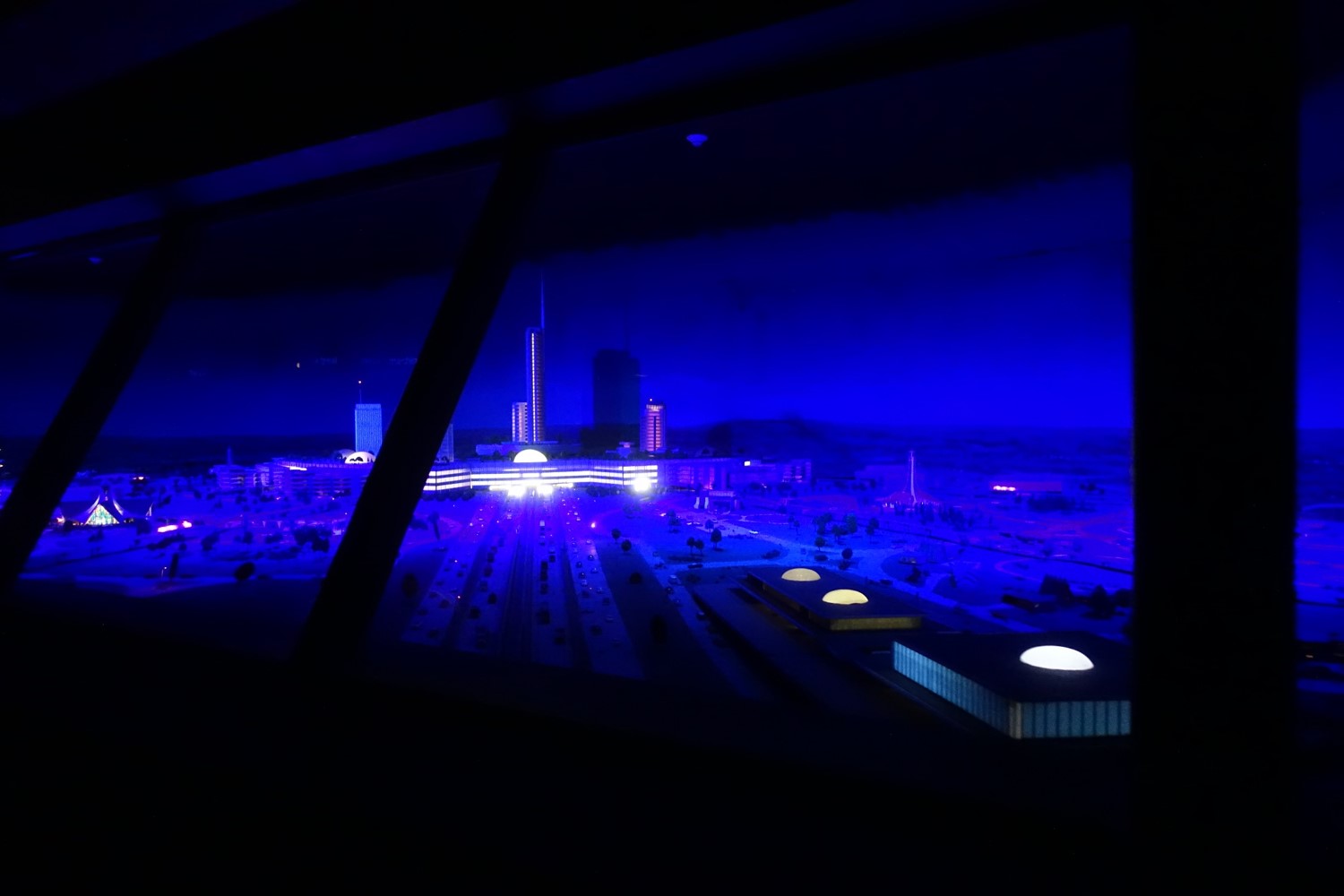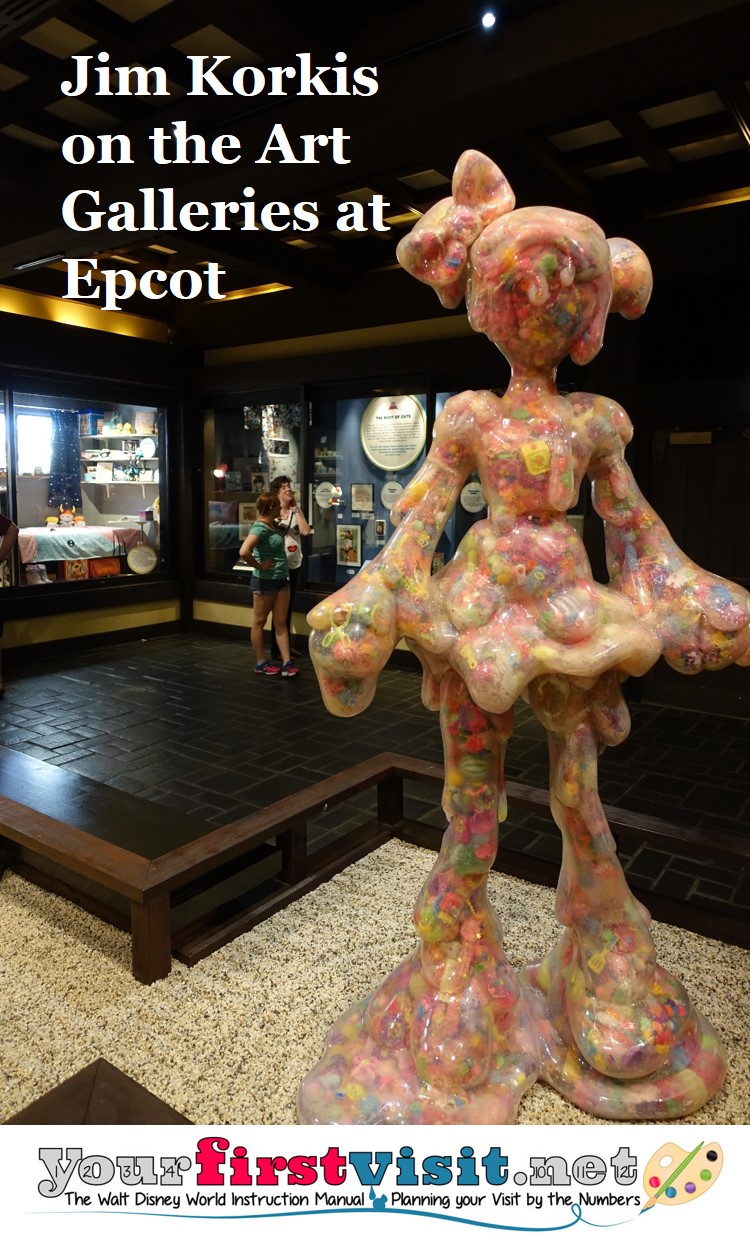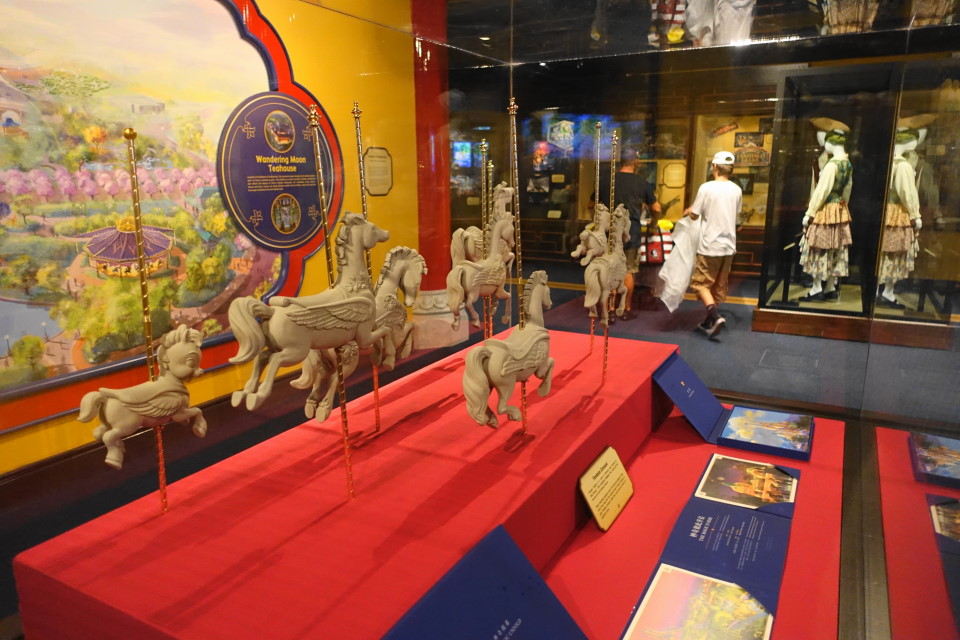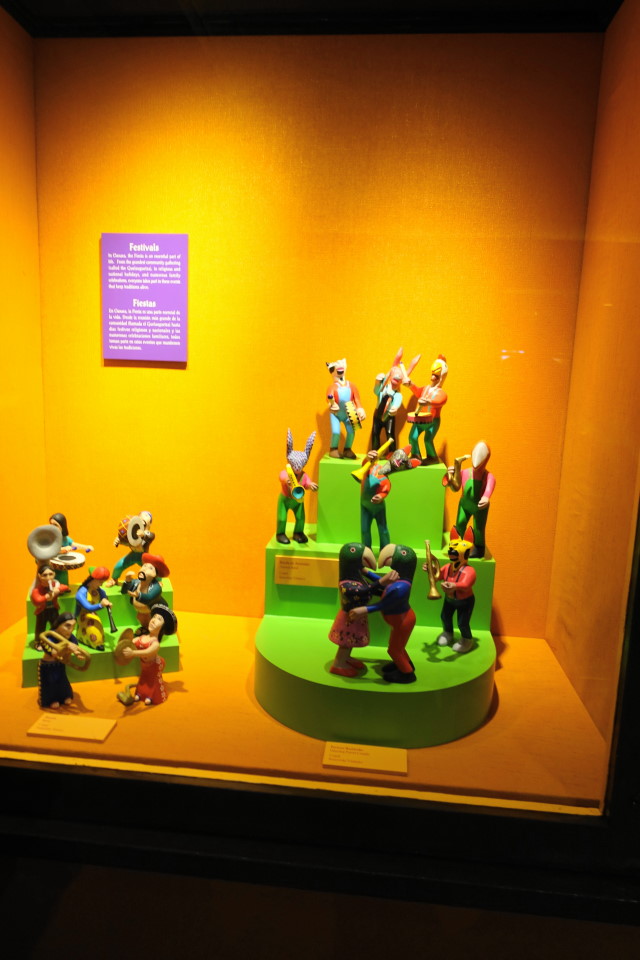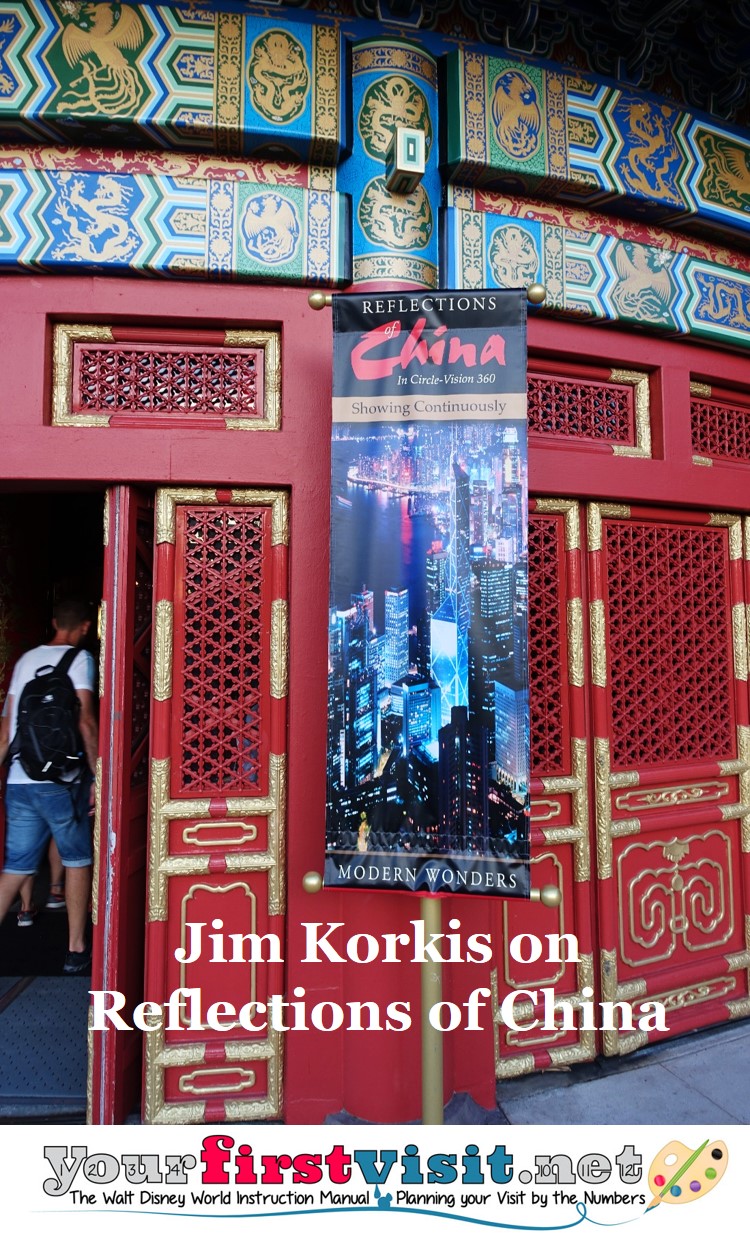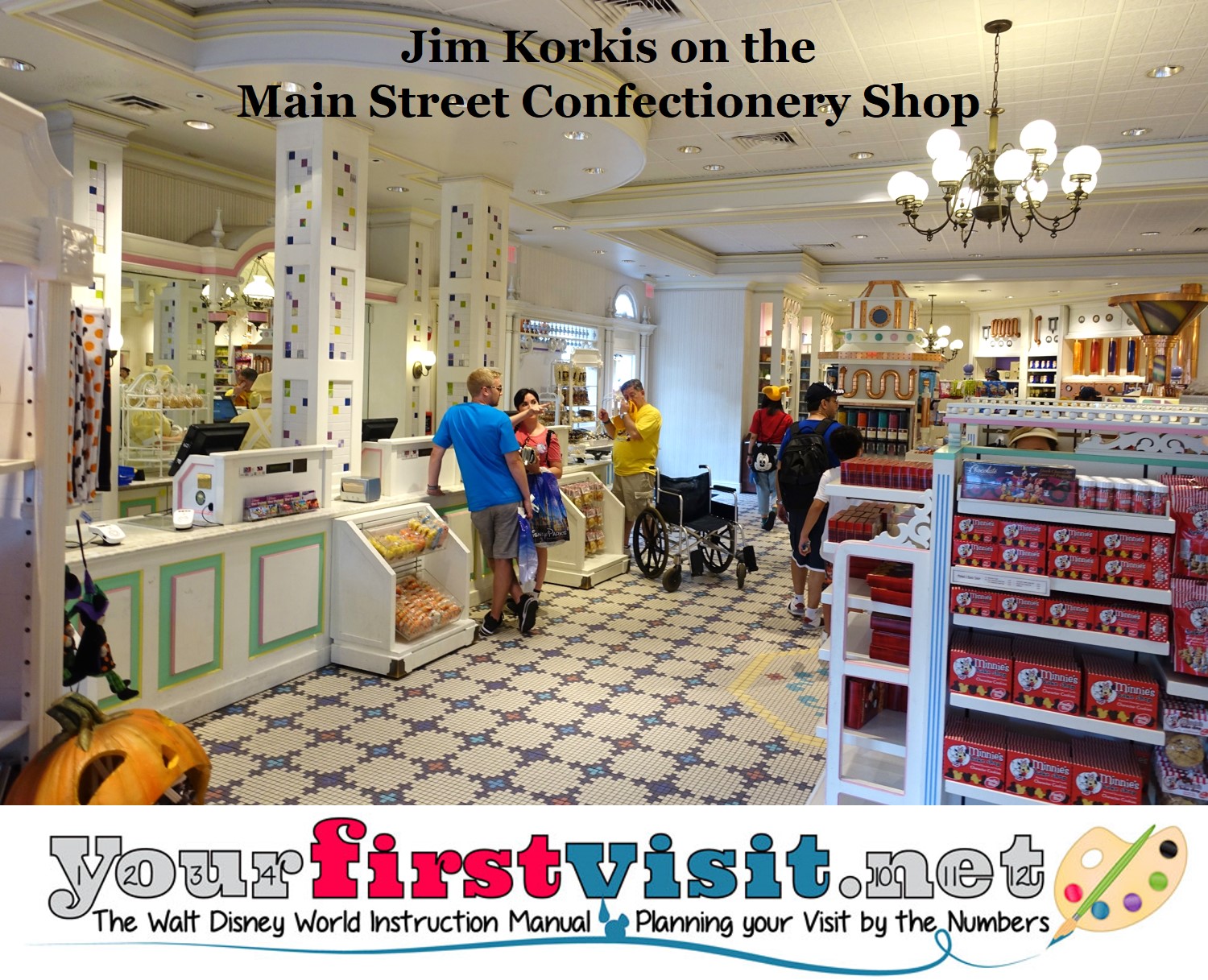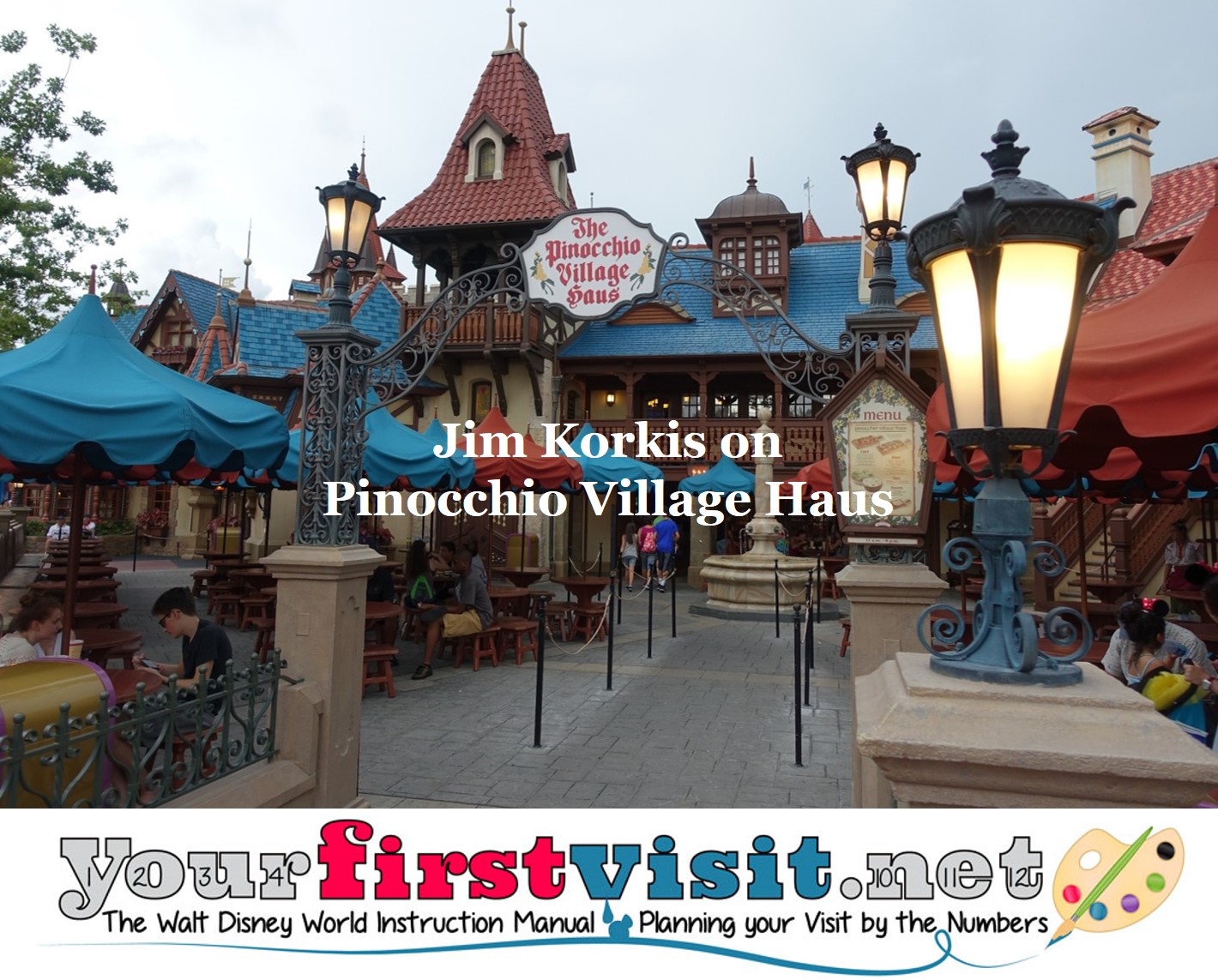Category — A Friday Visit with Jim Korkis
A Friday Visit with Jim Korkis: Treasures of the BoardWalk Inn
Welcome back to Fridays with Jim Korkis! Jim, the dean of Disney historians and author of Jim’s Gems in The easy Guide, writes about Walt Disney World history every Friday on yourfirstvisit.net.
TREASURES OF THE BOARDWALK INN AND VILLAS
By Jim Korkis
Alix Beeny was the director of Parker Blake, a Denver, Colorado design company hired by Disney Imagineering division to help explore themes and find artifacts from the glory days of both Atlantic City and Coney Island to add authentic touches to the Boardwalk Inn and Villas.
Hippocampus Electrolier. Hanging directly above the miniature carousel is the Hippocampus Electrolier that supposedly is a one-of-a-kind original and not a reproduction.
The classical hippocampus comes from Greek mythology and is a sea monster with a horse’s forequarters and a fish’s tail, quite literally a seahorse. Poseidon was not only the god of the sea, but also earthquakes and horses. He was often accompanied by hippocampi who pulled his chariot.
Electrolier was the name for a chandelier powered by electric lights, rather than gas or candle, but the term never caught on in common usage. Reportedly, it was inventor Thomas Edison who coined the term.
The Hippocampus Electrolier Chandelier at the Boardwalk Inn weighs 3,000 pounds and is finished entirely in 22-karat gold leaf, hand-cut Austrian crystal, and custom-blown glass. Underneath there is a glass globe that used to be filled with sand and a time capsule to be opened on the 50th anniversary of Walt Disney World. The globe developed a leak (or fell and cracked depending upon who tells the story) and the sand and the time capsule were removed and are supposedly in safe keeping.
Nanny Chairs. Placed on either side of the fireplace are the scary “nanny chairs” that were originally found on 19th century European carrousels. They were intended for adults to rest upon while their children rode the moving animals. From this concept developed the more traditional “chariot” benches. It would have been inappropriate for female nannies to even ride side saddle on a carousel horse. These reproductions were cast from circa 1889 originals, hand painted and highlighted with gold leaf. In a moment of cleverness, the two Imagineers involved in the reproductions printed their names on the back of each chair: Todd and Paul.
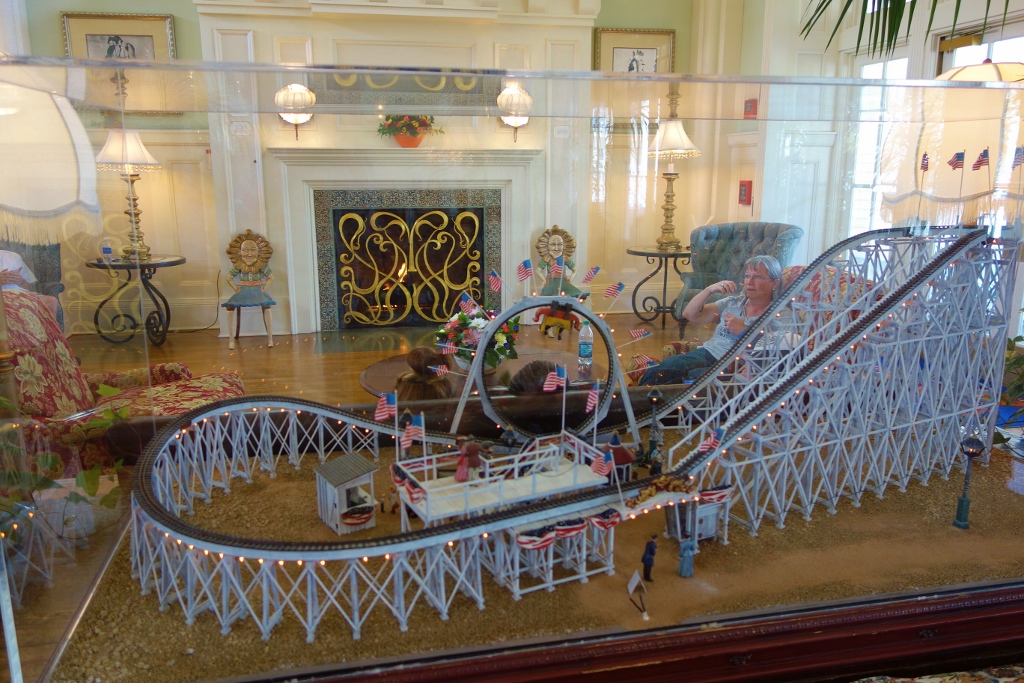
Built in 1895, this early ride featured a 25-foot loop and was the world’s first inverted (upside down loop-the-loop) roller coaster. Because of its design (and no seatbelts), there were neck and back injuries among other discomforts.
Atlantic City had its own version of the Flip-Flap (sometimes called the Looping the Loop) on Young’s Pier from 1902-1912. So, once again, both Coney Island and Atlantic City shared similar attractions.
The Coney Flip-Flap produced 12 Gs, enough to knock riders out. To put this in comparison, Epcot’s Mission: Space produces about 2.5 Gs for 45 seconds. Even the high-flying aerobatics of the Blue Angels only produces 9-11 Gs maximum. It is my understanding that this model was produced by Imagineering using extensive resources.
Swan Ride. On a table in the middle of the room is an authentic two-headed “Swan Seat.” According to the nearby sign, it “is of European origin from the period of large-themed carousels dedicated to one species of animal, bird or fish. These grand rides had dispensed with rocking gondolas or spinning tubes in favor of these more fanciful creations. Giant baskets carried the passengers on a “Manege des Cochons” (ride of pigs). This swan seat originally hung from chairs and rocked on the carousel floor from the shifting weight of the children inside. Iron and tin with hand painting and gold leafing circa 1890.
* * * * *
Thanks, Jim! There’s more on the BoardWalk Inn here, and come back next Friday for more from Jim Korkis!
In the meantime, check out his books, including Secret Stories of Walt Disney World: Things You Never You Never Knew, which reprints much material first written for this site, and The Vault of Walt: Volume 4, and his contributions to The easy Guide to Your Walt Disney World Visit, all published by Theme Park Press.
Follow yourfirstvisit.net on Facebook or Google+ or Twitter or Pinterest!!
October 7, 2016 No Comments
A Friday Visit with Jim Korkis: Tomorrowland
Welcome back to Fridays with Jim Korkis! Jim, the dean of Disney historians and author of Jim’s Gems in The easy Guide, writes about Walt Disney World history every Friday on yourfirstvisit.net.
BACK TO THE FUTURE IN TOMORROWLAND
By Jim Korkis
Walking down the main street of the Avenue of the Planets in Tomorrowland, guests find themselves in the central hub of Rockettower Plaza. The names are a playful reference to New York’s famous Rockefeller Plaza and the Avenue of the Americas.
It is a bustling area that allows easy access to all areas of the Tomorrowland “city” and is home to the Tomorrowland Transit Authority that was renamed the Tomorrowland Transit Authority PeopleMover in 2010 in homage to its original 1975 name of WEDWay PeopleMover.
This attraction serves as an urban mass transit system for the citizens and visitors to this popular space port. The Blue Line provided intra-city service to destinations throughout the city from a beauty parlor to a merchandise shop. It was also the delivery method for businesses like Earth Crust Pizza.
The unseen Green Line was for commuting to the Hoverburbs above the city and the unseen Red Line took riders off the planet to other destinations in the galaxy.
One of the treasures on the attraction is a small glimpse of the past representing Walt Disney’s vision of the future.
It is the display model of Walt Disney’s original concept for an Epcot-like city that was on the upper level post show for Disneyland’s Carousel of Progress for many years. This is only a small part of Walt’s model which was originally 115 feet wide and 60 feet deep with 2,500 moving vehicles, 20,000 trees and 4,500 structures. Walt insisted the interior of the buildings be finished, furnished and lit.
In 1994, the Star Jets attraction was updated along with the rest of the area and renamed Astro Orbiter. The huge central rocket was replaced by a highly stylized iron-work tower along with various planets on the outside of the attraction so it seems like the rockets were weaving between the planets.
The new storyline is that the League of Planets was giving inexperienced pilots an opportunity to learn how to fly their own rocket ship.
Nearby is an actual Metrophone booth from the Galactic Communications Network (GCN). As it states on the phone: “Bringing the World Closer Together. Toll Free From Anywhere in the Galaxy.”
Since 1999, punching several numbers at random will bring up one of nine possible hilarious one-sided conversations from Rocket Realty, Sonny Eclipse’s agent Johnny Jupiter, Earth Crust Pizza (delivering anywhere in the Solar System in less than two light years or your order is free), Intergalactic Movie Line (with information on the movie “Attack of the 50 Foot Earthling”), Psychic Robots Network and more.
By the entrance to the TTA PeopleMover, is a robot newsboy selling his newspapers. The Robo-Newz vendor is always up to minute and supposedly guests can get their daily paper printed “while u wait”.
The main case shows that the latest physical newspaper is a copy of the Galaxy Gazette with its headline: “Stitch Escapes!”
The Thirst Rangers in their red and white (the colors of Coca-Cola) rocket ship are perched high on a landing platform to deliver refreshment to a Thirsty Galaxy. The Disney Imagineers created this spaceship out of the hull of the Trimaxian Drone Ship from the 1986 Disney film, Flight of the Navigator, that was originally on view for several years in the boneyard on the backstage tour at Disney MGM Studios.
At the bottom of the platform are gray crates with images of a Coca Cola bottle and amusing shipping labels.
Tomorrowland is an example of inventive, clever and humorous storytelling that immerses guests into a future that never was but was what several generations hoped would happen.
* * * * *
Thanks, Jim! Come back next Friday for more from Jim Korkis!
In the meantime, check out his books, including Secret Stories of Walt Disney World: Things You Never You Never Knew, which reprints much material first written for this site, and The Vault of Walt: Volume 4, and his contributions to The easy Guide to Your Walt Disney World Visit, all published by Theme Park Press.
Follow yourfirstvisit.net on Facebook or Google+ or Twitter or Pinterest!!
September 30, 2016 No Comments
A Friday Visit with Jim Korkis: The Art Galleries of Epcot’s World Showcase
Welcome back to Fridays with Jim Korkis! Jim, the dean of Disney historians and author of Jim’s Gems in The easy Guide, writes about Walt Disney World history every Friday on yourfirstvisit.net.
THE ART GALLERIES OF WORLD SHOWCASE
By Jim Korkis
There are six art galleries in Epcot’s World Showcase, which allow Disney World guests the opportunity to more closely experience other cultures.
While each pavilion is staffed by cast members from that particular country along with merchandise as well as food and beverage locations that are representative of each country, the purpose of Epcot was to be educational and give greater understanding of America’s international neighbors and their histories.
Each of the six art galleries was designed to be of museum quality and to preserve the genuine artifacts from light, heat and humidity. The collections usually rotate out after three years based on the assumption that it takes an average guest about three to five years to return for a visit to Walt Disney World. In addition, the items on exhibit are generally on limited loan from private collections or the country itself.
“The galleries at Epcot represent a very, very important part of what I think the theme park experience is all about,” stated Van Romans, Director Exhibit Development Walt Disney Imagineering in 1989.
“Guests expect the rides. They expect restaurants and merchandising spaces. But they don’t expect to see absolutely wonderful historical things from other countries being shown. They are very surprised. These galleries are intimate and unique and hold some wonderful treasures.
“We worked closely with the Cultural Ministries in each country and I think that the United States and, in particular, Florida should be very proud that these collections are right within their grasp to be able to enjoy.
“The whole gallery program emphasizes these treasures. The material is all real. It is directly from their culture, directly from their history. We are the jewel box of the parks.”
The American Heritage Gallery is located inside the American Adventure building. Currently, it houses a private collection called “Re-discovering America: Family Treasures” from the Kinsey Collection. Art and artifacts pay homage to African Americans who helped build and transform a nation.
The Gol Stave Church Gallery is the smallest of the galleries because it is housed in a replica of a stave church. The gallery has previously featured an exhibit devoted to “The Vikings: Conquerors of the Seas” but with the transformation of the pavilion, it now showcases “Creating the World of Frozen” about the research in Norway that led to the making of the popular animated feature film.
The Gallery of the Whispering Willow is adjacent to the waiting area for Reflections of China to give guests a chance to experience it before the next showing of the film. The former “Tomb Warriors Guardian Spirits of Ancient China” collection has been largely (but not entirely) superseded with material about Shanghai Disney.
The Bijutsu-kan Gallery is inside the castle at the rear of the Japan pavilion. The latest exhibit is devoted to “Kawaii – Japan’s Cute Culture”. Kawaii is rooted in Japan’s Shinto past and has become a fundamental part of Japanese culture including food, fashion and architecture.
The Mayan Ceremonial Hall Gallery is located inside the pyramid in the Mexico pavilion. “Animalés Fantásticos Spirits in Wood” celebrates a modern Mexican folk art where in Mexican villages surrounding the city of Oaxaca gifted artisans create woodcarvings of animals, humans and mythical creatures.
The Gallery of Arts and History is connected to the Fez House in the Morocco pavilion. “Moroccan Style: The Art of Personal Adornment” presents how the craftsmanship of Moroccan decorative arts are a visual representation of cultural identity.
* * * * *
Thanks, Jim! Come back next Friday for more from Jim Korkis!
In the meantime, check out his books, including Secret Stories of Walt Disney World: Things You Never You Never Knew, which reprints much material first written for this site, and The Vault of Walt: Volume 4, and his contributions to The easy Guide to Your Walt Disney World Visit, all published by Theme Park Press.
Follow yourfirstvisit.net on Facebook or Google+ or Twitter or Pinterest!!
September 23, 2016 No Comments
A Friday Visit with Jim Korkis: Reflections of China
Welcome back to Fridays with Jim Korkis! Jim, the dean of Disney historians and author of Jim’s Gems in The easy Guide, writes about Walt Disney World history every Friday on yourfirstvisit.net.
REFLECTIONS OF CHINA
By Jim Korkis
When Epcot’s China Pavilion opened in 1982, it featured a Circle-Vision 360 degree movie called Wonders of China that gave foreigners a glimpse of areas of China that had rarely seen before by outsiders. This film closed in March 2002 and was replaced in May 2003 with a new movie called Reflections of China.
Jun Tang, Vice president of China Affairs for the Walt Disney Company, worked with government officials to implement Disney’s strategy in Chinese relations and maintain a consistent presence in that country. His challenge was to manage the contract negotiations and to seek support from China’s film communities to produce a new film.
In the twenty years since the first film, Hong Kong and Macau were returned to the borders of China and Shanghai became a thriving international metropolis.
“A project like this always has its ups and down,” said Tang in 2002. “China is so big and there were so many things we needed to take into consideration. But the filming was much smoother than the original twenty years earlier. With the advent of reform in China, working with foreign companies is more commonplace. This made our job much easier. All you need is communication.”
David Katzman was the director for Theme Park Productions, and in January 2002 took a team of Imagineers to China. They screened the original film Wonders of China to representatives from the China Research Institute of Film Science and Technology. Then they went over the film scene by scene, shot by shot.
Despite language difficulties, the group mapped out a plan to update the film.
“Some of our technical and production terms don’t translate perfectly,” explained Katzman. “We’d get these puzzled looks from the Chinese about things we take for granted. We had to constantly try to explain ourselves.”
Because of these difficulties, it took several months for both Disney and China to negotiate and approve everything.
Senior Imagineering Show Writer Steve Spiegel took the outline and created the final script.
In the original film, the character of Li Bai, a Tang Dynasty poet known in the West as Li Po, was the narrator and Spiegel felt it was so effective that he wanted to duplicate that same element in the new film. Unfortunately, the original actor who played the part of Li Bai was not available so another actor was cast and made up to look like not only Li Bai but the first actor as well.
Another challenge arose because the narration had to be in English, but the new actor cast in the role spoke no English at all.
“We had him pronounce everything phonetically,” recalled Spiegel. “Then we went back and re-recorded the dialogue with another Chinese actor who spoke English.”
Twenty-five percent of the original film was able to be kept because it primarily featured scenes of China’s natural beauty that had not changed in any significant way. However, the other seventy-five percent was new footage or footage that was originally shot for Wonders of China but not used.
“When you look at the landscape, the beauties of China have not changed,” said Tang. “The changes in China are not in the construction of the buildings. It’s in the people. They’re more open, more engaging and more sophisticated.”
Nine cameras on a specially made platform were used to photograph the new images over a two month period that included filming in seven Chinese cities. When filming the Huangshan Mountain sequence, over three dozen locals were hired to lift a 300-pound camera unit up 16,700 stone steps. Senior Imagineering Creative Executive Paula Kessler oversaw the entire project.
* * * * *
Thanks, Jim! Come back next Friday for even more from Jim Korkis!
In the meantime, check out his books, including Secret Stories of Walt Disney World: Things You Never You Never Knew, which reprints much material first written for this site, and The Vault of Walt: Volume 4, and his contributions to The easy Guide to Your Walt Disney World Visit, all published by Theme Park Press.
Follow yourfirstvisit.net on Facebook or Google+ or Twitter or Pinterest!!
September 16, 2016 No Comments
A Friday Visit with Jim Korkis: The Main Street Confectionery Shop
Welcome back to Fridays with Jim Korkis! Jim, the dean of Disney historians and author of Jim’s Gems in The easy Guide, writes about Walt Disney World history every Friday on yourfirstvisit.net.
MAIN STREET CONFECTIONERY SHOP
By Jim Korkis
The candy shop on Main Street is more than just a location to enjoy such treats as candy apples, Rice Krispie treats, cookies, different flavors of fudge, cotton candy, peanut brittle, and of course, chocolate.
In 1998, Imagineer Kevin Neary (who has authored several Disney related books) came up with an interesting concept for the redesign of the location that was developed and finished by Imagineering Show Writer Shawn Slater. They combined two details from Disney history.
The Chicago World’s Fair of 1893 (also known as the Columbian Exposition) was meant to celebrate the 400th anniversary of Christopher Columbus and his arrival in the New World. Walt’s father, Elias moved from Florida to Chicago in 1890 and found work as a carpenter for a dollar a day, seven days a week building pavilions for the fair.
He loved working on the fair and years later shared stories about it with an impressionable Walt, who was fascinated and obviously inspired to some day build a similarly impressive family friendly venue.
The Confectionery Shop on Main Street references that fair with a poster, announcing the Columbian Exposition, near the counter selling fudge and with all the mechanical devices throughout the store supposedly inspired by the fair’s Hall of Machinery.
When a young Walt Disney was in a desperate situation in November 1922 and close to losing his first animation studio, Laugh-O-grams, a local dentist, Dr. Thomas McCrum came to his rescue. He agreed to pay Walt $500 to make a short live action film about how bad things would happen to young people if they didn’t take good care of their teeth.
Tommy Tucker’s Tooth (1922) was not only Walt’s first educational film but provided money to pay off mounting debts and finance the production of the short Alice’s Wonderland.
The following is the back story of the shop:
“Thomas and Kitty McCrum had run a candy store on Main Street for as long as anyone could remember. In fact, they became famous for their sweet creations. But Thomas McCrum was never one for resting on his laurels. He was always looking for new and exciting ways to improve his candy making and increase his business.
“On a fateful trip to Chicago, for the World’s Columbian Exposition of 1893, McCrum found inspiration. He and his wife entered the Expo’s storied Machinery Hall and were mesmerized by the mechanical machinations on display.
“Upon returning home, McCrum set out to duplicate some of what he’d seen, applying the wondrous new innovations to the creation of chocolate and other such delicacies.
“He moved quickly from prototypes and test recipes to full-blown production. In no time, the McCrum’s little candy store had expanded, pushing into nearby storefronts and taking over an entire corner on the Town Square.
“Now, at the turn of the 20th century, the McCrum’s Main St. Confectionery is poised and ready to take advantage of a new era of technological advancement: the electric age!
“Kitty McCrum, of course, has had to hire additional help, especially to get through the busy season, when streams of tourists pour forth from the railroad station at the edge of town. But it’s all worth it to see the smiles on their faces.
Now if she and Thomas could only stop sampling their own creations.”
Besides utilizing elements of Disney history, the gag about the shop is that it is a dentist who is operating the store and, in a way, generating more business for his primary profession by selling cavity causing treats.
* * * * *
Thanks, Jim! Come back next Friday for even more from Jim Korkis!
In the meantime, check out his books, including Secret Stories of Walt Disney World: Things You Never You Never Knew, which reprints much material first written for this site, and The Vault of Walt: Volume 4, and his contributions to The easy Guide to Your Walt Disney World Visit, all published by Theme Park Press.
Follow yourfirstvisit.net on Facebook or Google+ or Twitter or Pinterest!!
September 9, 2016 No Comments
A Friday Visit with Jim Korkis: Pinocchio Village Haus
Welcome back to Fridays with Jim Korkis! Jim, the dean of Disney historians and author of Jim’s Gems in The easy Guide, writes about Walt Disney World history every Friday on yourfirstvisit.net.
PINOCCHIO VILLAGE HAUS
By Jim Korkis
If the 1883 children’s story about Pinocchio, the little wooden puppet who came miraculously to life, is Italian, then why does the restaurant in Magic Kingdom’s Fantasyland resemble a medieval Bavarian building and uses the German word “haus”?
Walt Disney specifically wanted his animated feature Pinocchio (1940) to have the same artistic approach that echoed the old world storybook illustrations done by German artists that had made Snow White and the Seven Dwarfs (1937) such a success.
For the film, concept artist Gustaf Tenggren was responsible for the design of the Alpine town in the shadow of the mountains. The Germanic influences include not only the architectural detail in the streets but also the carved interior of Gepetto’s workshop. The character of Gepetto is German as are the toys, clocks and music boxes he carves. Even actor Christian Rub who voices Gepetto was German.
Tenggren’s inspiration for the buildings, signs, streets, steps and more in the final film were from the many drawings he had done of a Bavarian town called Rothenburg ob der Tauber. Gepetto’s house bares a close resemblance to the Hotel Altfrankische Weinstube in that town.
In fact, Pinocchio’s Village Haus was meant to so precisely recall the classic animated feature, that the view from above, which when the Magic Kingdom opened in October 1971 could be enjoyed on a leisurely Skyway ride that closed in November 1999, resembles the overhead opening scene in the film.
That view, as well as the one in the film, included a distinctive bell tower. Imagineer John Hench had located an old rusting, dented bell that was able to duplicate the exact ringing tone necessary.
Unfortunately, after the bell was shipped from California to Florida, overeager workmen in Central Shops cleaned off the rust and hammered out the dents and the bell no longer had its pleasing tone. An audio electronic track was substituted.
The world “village” was chosen specifically for this food and beverage location because both the exterior and the interior are designed with a village courtyard and separate “houses” clustered together since a building this large would not have served as a restaurant in medieval times. There are even different weather vanes on the roof to suggest different businesses or families living below.
The main entrance, although indoors, is designed to invoke the outdoors with a lighted ceiling suggesting the sky and the various food counters having shingled roofs on building facades with stained glass windows and flowerboxes.
The largest dining area is the Stromboli Room. Outside the building is puppeteer Stromboli’s cart that he uses to travel from town to town to perform his puppet shows and sell merchandise. Entering from that cart into the building takes a guest into the puppet theater.
The long, thin stained glass windows feature marionettes on strings while the narrow small balcony up above the seating area is meant to suggest the catwalk of a theater. A large fresco on the wall reads, “Stromboli presents Pinocchio the string-less puppet” just like a poster for the show.
Each of the other dining rooms are homages to different characters from Pinocchio: The Blue Fairy, Geppetto (with wooden cuckoo clocks), Cleo (all glassed in like a fish bowl with images of the fish swimming), Figaro, Jiminy Cricket, and Monstro (near the window overlooking the Small World oceans where he roamed).
The location even includes two porcelain tile covered authentic German bakery ovens that still work. An architectural mistake in the installation of an Exit sign has been corrected by painting the mischievous cat Figaro seemingly playfully moving it off center.
* * * * *
Thanks, Jim! Come back next Friday for even more from Jim Korkis!
In the meantime, check out his books, including Secret Stories of Walt Disney World: Things You Never You Never Knew, which reprints much material first written for this site, and The Vault of Walt: Volume 4, and his contributions to The easy Guide to Your Walt Disney World Visit, all published by Theme Park Press.
Follow yourfirstvisit.net on Facebook or Google+ or Twitter or Pinterest!!
September 2, 2016 No Comments




